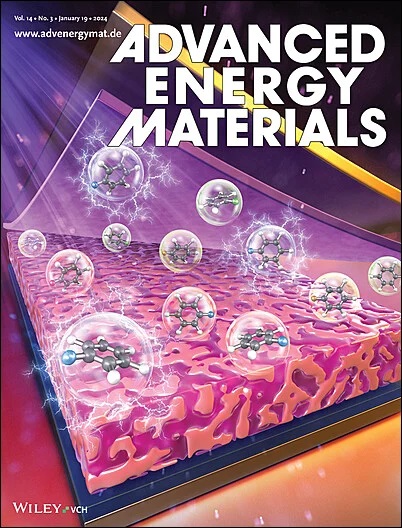Understanding the Metal-Center Mediated Adsorption and Redox Mechanisms in a FeMn(NbTa)2O6 Columbite Material for Anion Exchange Membrane Water Electrolyzers
IF 24.4
1区 材料科学
Q1 CHEMISTRY, PHYSICAL
引用次数: 0
Abstract
The rising demand for sustainable green hydrogen production necessitates efficient and cost-effective water-splitting electrocatalysts. Inspired by the catalytic activities of columbite-tantalite, this study combines a scalable cutting-edge synthesis approach with atomic-level structures and metal-center-mediated mechanisms to unravel its operational performance and stability. Using ad in situ X-ray absorption fine structure combined with Density Functional Theory (DFT), the results reveal distinctive valence band peaks and moderate charge transfer from Mn and Fe sites, enabling stable adsorption and reduced activation barriers. In contrast, the high-valence Nb and Ta centers at the B-sites promote favorable d-band alignment, enhancing orbital overlap with oxygen p-orbitals. This facilites electronic delocalization, lowers charge accumulation, and reduces activation barriers of intermediates species. Fe and Mn at the A-sites exhibit strong redox reactivity and optimal adsorption for OH* and O*, supporting efficient electron fransfers. Solvation effects modeled via VASPsol further stabilize key intermediates, especially O*, reducing the energy barrier for water dissociation. Notably, FeMn(NbTa)2O6-columbite catalysts stand out with a cell voltage of 1.81 V at a current density of 700 mA cm−2, compared to 40% Pt/C-RuO₂ (1.75 V) at the same current density in the anion exchange membrane water electrolyzer (AEMWE). Also, the FeMn(NbTa)2O6-columbite exhibits long-term stability at 800 mA cm−2, surpassing the benchmark 40% Pt Vulcan-RuO2 after 200 h in AEMWE. This work significantly advances current research and establishes a design rule for selecting metal compositions in the development of advanced electrocatalysts in alkaline water electrolyzers.

求助全文
约1分钟内获得全文
求助全文
来源期刊

Advanced Energy Materials
CHEMISTRY, PHYSICAL-ENERGY & FUELS
CiteScore
41.90
自引率
4.00%
发文量
889
审稿时长
1.4 months
期刊介绍:
Established in 2011, Advanced Energy Materials is an international, interdisciplinary, English-language journal that focuses on materials used in energy harvesting, conversion, and storage. It is regarded as a top-quality journal alongside Advanced Materials, Advanced Functional Materials, and Small.
With a 2022 Impact Factor of 27.8, Advanced Energy Materials is considered a prime source for the best energy-related research. The journal covers a wide range of topics in energy-related research, including organic and inorganic photovoltaics, batteries and supercapacitors, fuel cells, hydrogen generation and storage, thermoelectrics, water splitting and photocatalysis, solar fuels and thermosolar power, magnetocalorics, and piezoelectronics.
The readership of Advanced Energy Materials includes materials scientists, chemists, physicists, and engineers in both academia and industry. The journal is indexed in various databases and collections, such as Advanced Technologies & Aerospace Database, FIZ Karlsruhe, INSPEC (IET), Science Citation Index Expanded, Technology Collection, and Web of Science, among others.
 求助内容:
求助内容: 应助结果提醒方式:
应助结果提醒方式:


